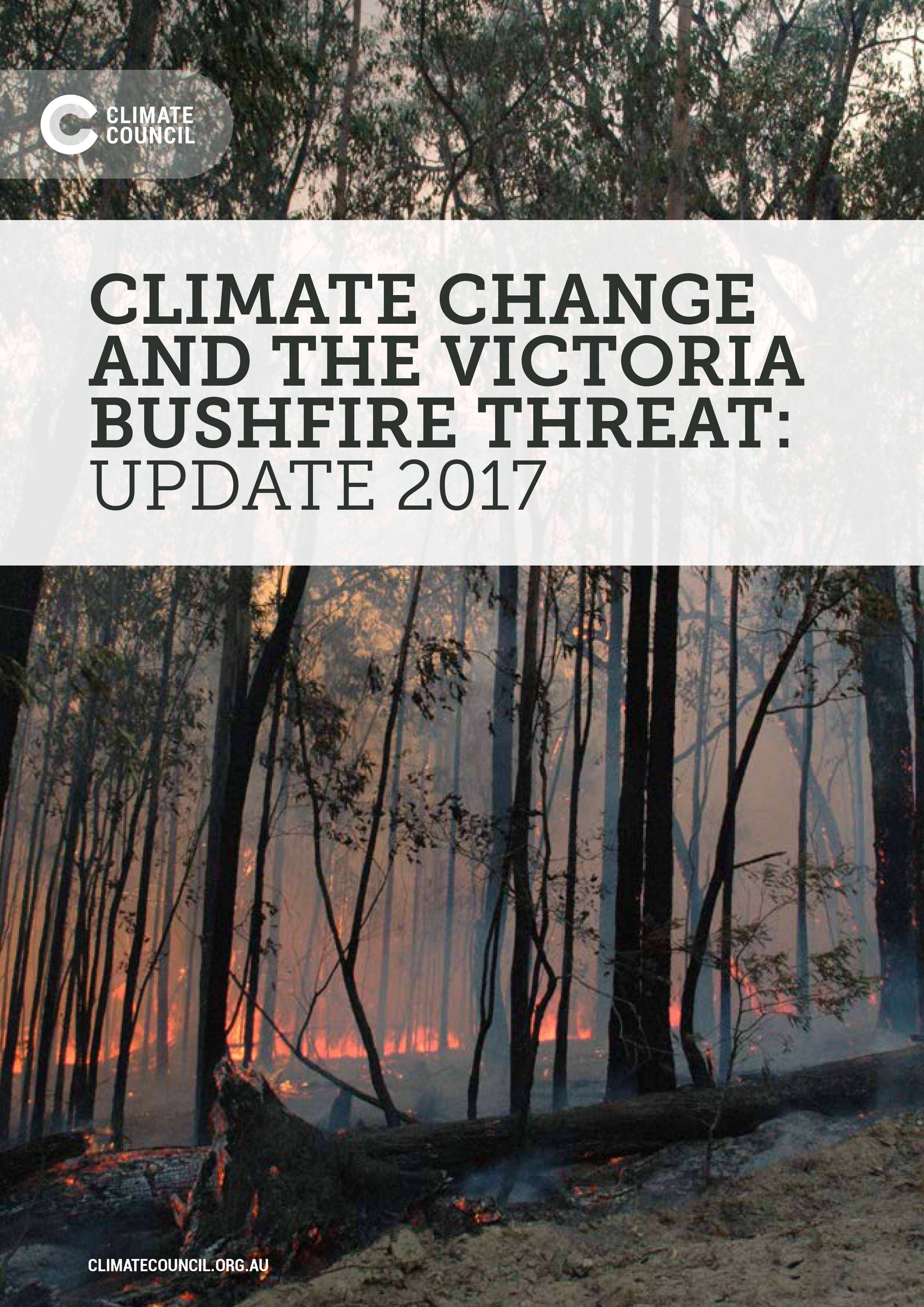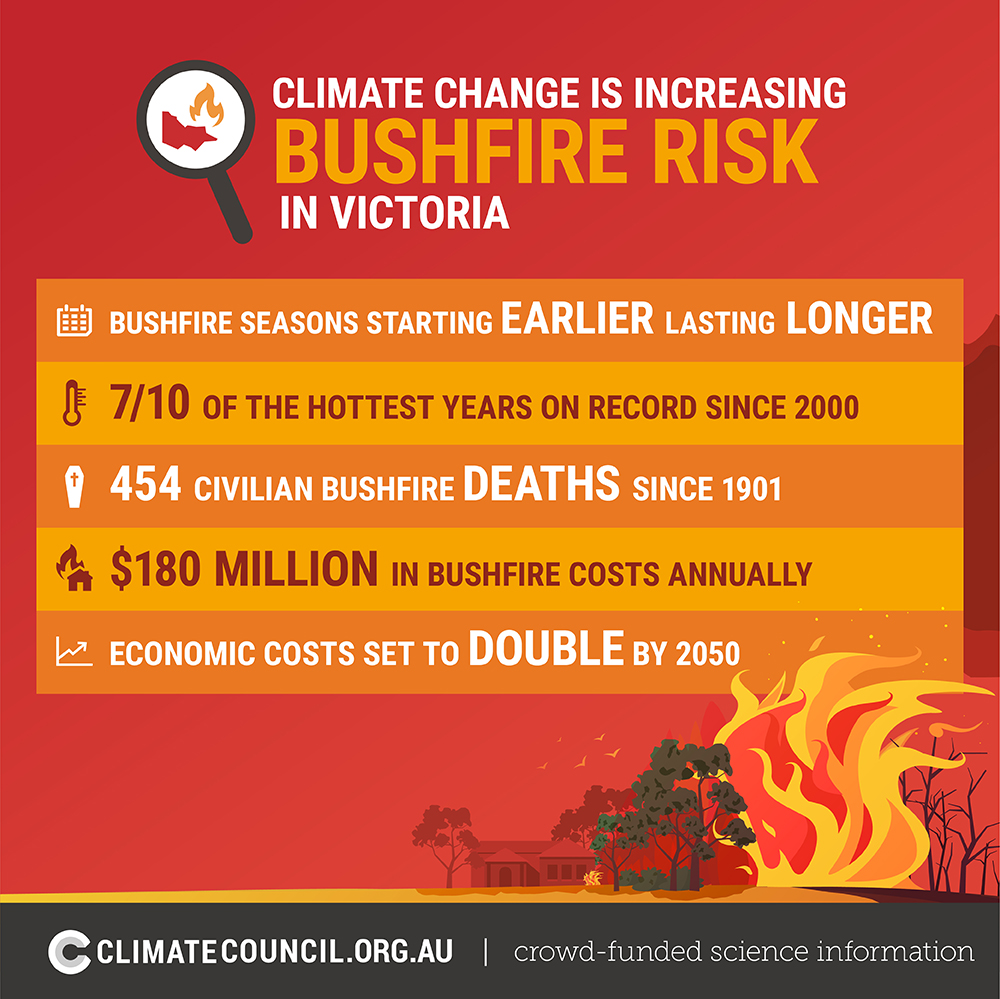This content is more than 7 years old
Victoria is on the brink of an extreme bushfire season as climate change continues to intensify bushfire risk, our new report reveals.
The economic toll of Victoria’s bushfires is projected to more than double by 2050, with the state bearing the brunt of Australia’s economic losses from bushfires, the report finds.
DOWNLOAD THE REPORT
DOWNLOAD THE INFOGRAPHIC
KEY FINDINGS
1. Climate change is increasing the risk of bushfires in Victoria and lengthening fire seasons.
- Extreme fire weather has increased since the 1970s in the east and south of Australia, including Victoria, with the fire season length extending from October to March.
- Climate change is now making hot days hotter, and heatwaves longer and more frequent. Drought conditions have been increasing in Australia’s southeast.
- Climate change is driving an increase in dangerous fire weather, which in turn is increasing the frequency and severity of bushfires.
2. Victoria is the state in Australia that is most affected by bushfires and is on the frontline of increasing bushfire risk.
- The 2016–17 bushfire season in Victoria is expected to be ‘above normal’ for the majority of the state including the Melbourne hinterland.
- Severe long term rainfall deficits remain across much of western Victoria and West and South Gippsland, which may increase fire risk. Very wet winter and spring conditions has led to high levels of grass growth and above average fuel loads, particularly in the north of the state.
3. The economic cost of bushfires in Victoria is projected to more than double by 2050.
- Victoria has sustained around half of the Australian economic losses from bushfires despite comprising only 3% of the continent.
- The annual economic cost of bushfires in Victoria is approximately $180 million.
- By around the middle of the century these costs could more than double to $378 million. These projections do not incorporate increased bushfire incident rates and severity due to climate change, so the total cost is likely to be much higher.
4. Bushfires will continue to adversely affect human and environmental health.
- More than two thirds of known civilian bushfire fatalities in Australia have occurred in Victoria (more than 450 fatalities since the start of the 20th century).
- Bushfire smoke can seriously affect human health because it contains respiratory irritants, as well as inflammatory and cancercausing chemicals. Elderly, infants and those with chronic heart or lung diseases are at higher risk.
- After the 2009 Black Saturday bushfires, some members of the community developed Post Traumatic Stress Disorder, major depressive episodes and increased alcohol use.
- Fires can affect water infrastructure. The Black Saturday fires affected about 30% of catchments supplying Melbourne’s drinking water, with estimated recovery costs totalling more than $2 billion.
- Increasing fire frequency can cause rapid ecosystem change. After successive fires in 2003 and 2006–07, acacia shrublands replaced some mountain and alpine forests, putting at risk vertebrate species including the endangered Leadbeater’s possum.
5. In the future, Victoria is very likely to experience an increased number of days with extreme fire danger. Communities, emergency services and health services across Victoria must keep preparing.
- Fire severity and intensity is expected to increase substantially in coming decades in Victoria. The fire season will continue to lengthen, further reducing the opportunities for safe hazard reduction burning.
- Melbourne’s rural-urban fringe is among the most vulnerable in the world to bushfires. The population of Melbourne is continuing to spread, encroaching into surrounding bushland, increasing risk to life and property from bushfires.
- An increased likelihood of dangerous fire weather and a lengthening fire season will strain Victoria’s existing resources for fighting and managing fires.
6. Reducing emissions is critical to protecting Australians.
- Australia must cut its emissions rapidly and deeply to join global efforts to stabilise the world’s climate and to reduce the risk of even more extreme events, including bushfires.
- Australia’s very weak target of a 26-28% reduction in emissions by 2030 compared to 2005 levels – and we are on track to miss even this target – leaves Australia lagging well behind other OECD countries.
DOWNLOAD THE REPORT

